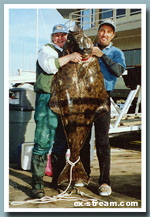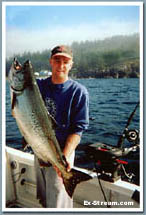 |
| Saltwater
Tips |
In any Salmon area, the Secret to being Successful, is to Match
your Lure or Bait Size to the Natural Forage of the Salmon. Needle fish,
Sandlance, Herring and Anchovies are the "Groceries" for our tasty Friends. Then Match the "food" Depth and your Rods will Bounce!
The Secret to Halibut Fishing our Entire West Coast is fishing Flood
Tides and the real estate saying -" location, location, and location".
Best
"Hali" Baits are Octopus, Herring, Salmon and Mackerel. My first choice when bait
fishing is a combo of Herring and Halibut skin {the white side}. If the
Herring falls off, the skin holds firm allowing Halibut to "eyeball" more
than just bare hooks. I also like using a small piece of Octopus, either
with Herring or sandwiched between my Herring/skin combo. A lot of anglers
are successfully use Salmon Heads and Gills too. Lots of large "Barndoors" out there, so be prepared and learn how to safely land them!
Catch ya Later
Ex-Stream Guide
scott@ex-stream.com
It is always a Good Idea to check the line on your reels
to make sure you are not using severely weakened line. There
are many factors that can effect the strength of your line,
which can cost you fish!
Nicks,kinks and line stretch on your
main line can weaken monofilament up to 40% from it's regular
strength. So it's a Good Habit, after every three hard days of fishing,
to peel off 20 feet of line from your reels. By doing that you
will reduce the chance of using worn and weakened line and improve
your chances of landing "The Big One."
Make sure that all old knots are clipped from swivels,
hooks and lures. Always clip excess line from your knots to
help prevent tangles and improving your presentation.
When heading out for a day on the Ocean always check
the Tides. Your Best Bet for hitting some fish will be one hour
before and after the tide change. During that time the water
is at it's slackest and that allows salmon to feed ferociously
without being pushed around by a strong current. So plan your
day around definitely having your rods in the water around the
tide changes!
Between tide changes it is also important to be fishing
hard. If fishing is slow, a great way to improve productivity
is by working your gear. Working your gear means checking your
lines every 15-30 minutes. No matter if trolling with downriggers
or power mooching with cut plugs, you will be amazed with how
many fish you hit within one minute of setting the rod back
in it's holder! Checking your gear every 15-30 minutes also
prevents you from trolling around for hours on end with kelp
on your line or with your gear tangled up - and that will never
catch you fish!
Before heading offshore to hunt for "Hallies", it is very important
to check the marine weather forecast. Offshore winds can pick
up very quickly and make for a very dangerous and uncomfortable
ride back to sheltered waters. Your best bet for fishing halibut
would be on the slack tide. Slack tide will enable your bait
to get down to the bottom without alot of weight. When fishing
for "Butts" it is best to keep changing your spot every 30-45
minutes until you start hitting them steadily. It is a definite
must to move if you get into alot of rockfish or those dreaded
dogfish. Sometimes you only have to move 50 meters to get into
the hard hitting "Hallies". Also a slight change of depth can
be productive and you don't always have to keep on going deeper
to find those Enormous " Barndoor " Flounders.
Ex -Stream Guide
Paul (Two -Stroke) Deslauriers |
|
|
eX-stream MENU  |
|
|


|






